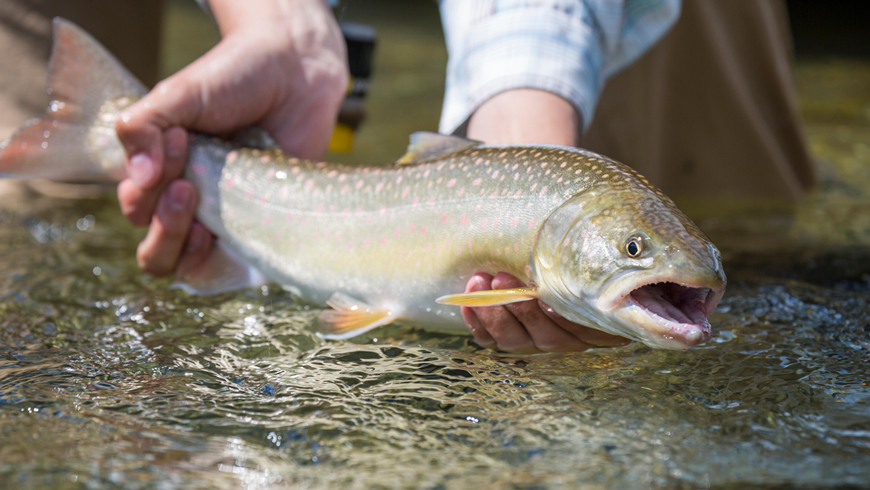As the late Pleistocene Epoch gave way to the Holocene Epoch some 12,000 years ago, the American Pacific Northwest was in a state of flux. Large mammals such as woolly mammoths, mastodons and giant ground sloths had only recently become extinct, a result of human overkill, climate change and perhaps a wayward meteor that impacted the Earth around the terminus of the last ice age. Conversely, Salvelinus confluentus, commonly known as the bull trout, was flourishing.
These salmonids earned their name due to their relatively large heads in comparison to their body lengths, an indication of an aggressive predatory nature. In fact, they are inaccurately named, as they are not actually trout but are char, as are their cousins, Dolly Varden trout.
Though similar in appearance, feeding habits and habitat selection to trout, char maintain light spots on a dark background rather than dark spots on a light background, as do true trout, among other taxonomic differences.
Endemic to Idaho, the bull trout is emblematic of cold, clear and unpolluted streams, rivers and lakes and is considered an indicator species, which reflects the health of the vast Columbia River drainage ecosystem.
Listed in 1997 as a threatened species in the Columbia River Basin, the future of bull trout is of concern to many biologists, angling conservationists, and Idahoans, in addition to residents of Washington, Oregon, Montana, and Nevada where the species also resides. Populations in British Columbia, Alaska and the Yukon remain stable where bull trout are considered a prized game fish.
Bull trout can be residential or migratory in nature, preferring relatively cold-water habitats, which include small headwater streams, mountainous river systems and the lakes that often feed them. Because of their multiple identities as lacustrine, riverine and anadromous fish, bull trout populations are difficult to monitor, study and count. But it is the wide range of habitat and migratory or residential behavior that is the char’s saving grace, as risk of extinction is limited due to its significant reach and dispersion.
Sea-run bull trout have been documented at lengths exceeding 40 inches and weights of 30 pounds, though resident bull trout in mountain environments rarely exceed lengths of 20 inches, weighing in at about 4 pounds. The Idaho state record was caught in 1949—when the harvesting of bull trout was legal—in Lake Pend Oreille, and weighed a whopping 32 pounds. The Idaho catch-and-release record was landed in the Salmon River and measured 23.5 inches in length, though rumors abound of significantly larger specimens being landed.
Bull trout don’t sexually mature and reproduce until an average age of five years with some specimens in higher-elevation, colder-temperature streams reproducing at the age of eight years. Life expectancy for this mountainous char is generally in the 10-to-12-year range, which is considered extremely advanced for a salmonid species.
Though traditionally assumed to be one and the same genus as the Dolly Varden, fisheries biologists recognized the unique nature of the bull trout in 1980 when the “Dolly,” Salvelinus malma, was given its own species-specific designation.
Bull trout are apex predators in their ecosystems, at least most of the time. Bulls often live in river systems that are seasonal homes to various salmon species and sea-running steelhead. These anadromous salmonids contribute food for the bull trout, both when laying eggs in their spawning beds and as the eggs mature into smolt, which is a major food source for the carnivorous ambush predator. In fact, once mature, the bull trout’s diet consists primarily of fish, which may include whitefish, sculpins and other trout.
Though dominant and threatening to the fish species that live around them, bull trout are also very sensitive to their surroundings, and even minimal human impact on their habitat can result in forced migration or extirpation in a given environment.
Bull trout are most comfortable in water temperatures at or below 48 degrees Fahrenheit, far cooler than the 55-to-65-degree waters that most often provide habitat to their rainbow and brown trout cousins. Therefore, waters unnaturally warmed by habitat degradation, such as logging, agriculture and damming practices, tend to be disastrous for S. confluentus. Additionally, these practices often result in increased siltation, which can affect the spawning beds of bull trout, a factor, even in relatively low levels, that can impede reproduction.
The standard formula for extinction within species is considered to be a function of three specific factors: fragmentation of population, degradation of habitat, and the introduction of catastrophic events.
Regarding bull trout, this formula is becoming dangerously applicable as dams have blocked fish migration, warmed water temps, and devastated fish populations through turbine fatalities and reduced river flows.
Degradation of habitat has also occurred due to logging practices, which add silt to river systems through unnatural erosion while also eliminating the streamside shade trees that help to keep water temperatures cool.
Agricultural practices add to the bull trout’s burden by siphoning off water from naturally flowing waterways and returning the water at a warmer temperature, often with pesticides in it that are used to treat crops.
Ironically, however, it is the fragmentation of population that may ultimately save the species from further decline or extinction. By populating an abundance of headwater streams in a six-state, two-province region, bull trout inhabit a relatively wide geographic area and are therefore less exposed to catastrophic events.
As far as their place in the wild, mountainous Idaho ecosystems that serve as home for this aggressive and iconic fish, the bull trout appears to be hanging on reasonably well despite the looming challenges.
In fact, as conversations regarding the possible elimination of the four Upper Snake River dams gain momentum, perhaps the brightest days of the bull trout lie ahead, unlike those of the long-haired, tusked beasts that once roamed the same habitats thousands of years ago, ultimately succumbing to the many environmental and human-created pressures that led to their extinction.


